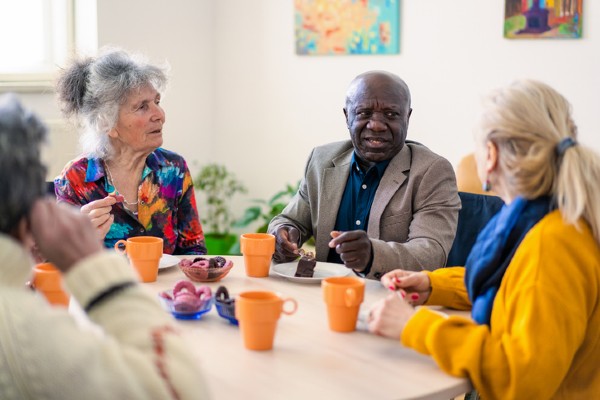As seniors and their caregivers encounter the complexities of aging, short-term or respite care stays at senior communities offer a unique opportunity to experience community living without long-term commitments. These temporary stays provide a valuable trial period that can help seniors and their caregivers decide if a senior community is the right fit for their needs as they age in place.
Here, we explore five ways seniors and their caregivers can use short-term stays as a “tryout” for senior community living.
1. Experiencing the Community Firsthand
A short-term or respite care stay allows seniors to immerse themselves in the daily life of a senior community, providing a clear picture of what long-term living would be like.
By staying in the community, seniors can get a genuine feel for the daily rhythms and routines. They can observe and participate in activities, experience mealtime routines, and see how the community operates on a daily basis. This hands-on experience is invaluable in determining whether the community’s lifestyle matches their own.
Each senior community has its own unique culture and atmosphere. During a short-term stay, seniors can interact with fellow residents and staff, attend social events, and engage in community activities. This immersion helps them understand the social dynamics and determine if they feel a sense of belonging and camaraderie.
Engaging with the caregiving and administrative staff during a short-term stay allows seniors to assess the level of professionalism, friendliness, and responsiveness. Positive interactions with staff can significantly influence a senior’s comfort level and their decision to move in permanently.

Download The Complete Guide to Senior Housing
As you begin to look into senior housing options for yourself or your loved one, you may be confused by the variety of choices. Learn what you need to know from our free eBook.
Download the Guide2. Evaluating Services and Amenities
During a short-term stay, seniors can evaluate the quality and variety of services and amenities offered by the community.
Access to on-site healthcare services is crucial for many seniors. A short-term stay provides the opportunity to experience the availability and quality of medical care, nursing support, physical therapy, and wellness programs. Seniors can assess whether the community can meet their current and future health needs.
Engaging in the community’s recreational activities allows seniors to gauge the range and quality of social and leisure opportunities. From fitness classes and arts and crafts to social clubs and educational workshops, participating in these activities can help seniors determine if the community offers sufficient stimulation and engagement.
Experiencing the dining options firsthand is important for many seniors. During a short-term stay, they can sample the food, assess the variety and quality of meals, and determine if the dining schedule and environment meet their preferences and dietary needs.
3. Assessing the Fit for Aging in Place
Short-term stays offer a practical way for seniors to assess whether the community can meet their long-term needs as they age in place.
Evaluating the living accommodations is essential to ensure they are comfortable and adaptable to any future mobility changes. Seniors can decide whether the rooms or apartments are spacious, well-designed, and equipped with necessary safety features.
Understanding the community’s continuum of care options is crucial for long-term planning. During a short-term stay, seniors can explore the different levels of care available, from independent living to assisted living and memory care. This helps them determine if the community can provide the appropriate level of support as their needs evolve over time.
Experiencing how the community develops and implements personalized care plans can give seniors confidence in the level of individualized attention they will receive. Checking on the staff’s ability to tailor care to meet specific health requirements and personal preferences is key to ensuring a good fit for aging in place.
4. Building Familiarity and Comfort
A temporary stay can ease the transition to permanent residency by building familiarity with the community, staff, and residents.
Establishing a daily routine within the community during a short-term stay can help seniors feel more comfortable and at ease. They can become accustomed to the schedule of activities, meal times, and the overall pace of life within the community. This familiarity can significantly reduce anxiety and resistance to a permanent move, making the transition smoother and more welcoming.
Building relationships with both staff and fellow residents is a key component of feeling at home in a new environment. A short-term stay provides ample opportunity for seniors to socialize, form friendships, and get to know the caregivers who will be supporting them. These connections can foster a sense of belonging and security, making the idea of a long-term stay more appealing.
Living in the community, even temporarily, allows seniors to experience firsthand the comfort and quality of the accommodations, the responsiveness of the staff, and the overall atmosphere. This personal experience can dispel any misconceptions or fears about senior community living, providing a realistic perspective that can aid in decision-making.
5. Gaining Family Peace of Mind
Families gain reassurance knowing that their loved one is in a safe and supportive environment, which can inform their decision-making process about long-term care.
Observing the community’s safety measures and emergency protocols firsthand can provide peace of mind about their loved one’s well-being. Families can see how the community handles medical emergencies, security issues, and everyday safety concerns, ensuring that their senior family member is well-protected.
Families can evaluate the consistency and quality of care provided during a short-term stay. This includes assessing how well the staff addresses medical needs, personal care, and any special requirements their loved one may have. Seeing the care in action helps families feel confident in the community’s ability to provide high-quality, compassionate care.
Families can also use short-term or respite care stays for the seniors they love as a break from their own responsibilities caring for them. Caregiving can be a challenge, so trying out a senior care community can serve a dual purpose of taking a time out and exploring future arrangements.
Find Your New Home at a Senior Lifestyle Community
Short-term or respite care stays at senior communities offer an invaluable opportunity for seniors and their families to “try out” community living. This trial period allows seniors to experience the community’s culture, services, and amenities, providing a clear understanding of what long-term residency would entail.
Senior Lifestyle communities can help seniors, and their family members, live a worry-free life while we take care of the everyday needs of living, such as cleaning and meal preparation.
Find out more about Senior Lifestyle or schedule a visit today.

